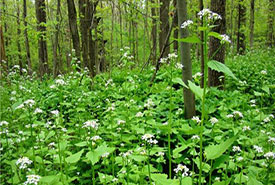
With the passing of Victoria Day, we in southern Ontario re now safely in the “no frost” zone of the calendar. I am loving all the flowers and happy green leaves filling the gardens and roadsides I pass daily. Equally happy, though considerably more distressing to see, are the invasive species trying to edge out all those lovely native plants—including the dastardly dog-strangling vine, and garlic mustard. (Unfortunately, not the tasty kind that we make!) At the moment, all we can do to battle these two invaders is personally pull each of them out, roots and all, seal them in plastic, and throw them in the garbage. Which is pretty effortful, and sets a high bar for effectively eliminating them.
But a team of researchers from Australia (a country that knows a thing or two about invasive species) may have great news for us. They’ve developed a brand new type of weed killer—incredibly, based on an antibiotic that was developed for tuberculosis! The molecule failed out of the lab but showed promise for this new, but chemically similar, application. Its attack-the-bad-guys capability was tweaked to hone in on two of Australia’s most problematic weeds, annual ryegrass and wild radish. The formulation has proven effective at the targeted assassination of these two weeds. Scientists are now excited about what this development means for agriculture, in an age when food resources are ever more precious, and weeds are developing greater resistance to standard herbicides.
“Researchers at the [University of Adelaide] Herbicide and Antibiotic Innovation Lab discovered there were similarities between bacterial superbugs and weeds at a molecular level.
They exploited these similarities and, by chemically modifying the structure of a failed antibiotic, they were able to block the production of amino acid lysine, which is essential for weed growth. […]
‘The short-cut strategy saves valuable time and resources, and therefore could expedite the commercialisation of much needed new herbicides,’ said [lead researcher Dr Tatiana] Soares da Costa.
‘It’s also important to note that using failed antibiotics won’t drive antibiotic resistance because the herbicidal molecules we discovered don’t kill bacteria. They specifically target weeds, with no effects on human cells,’ she said.”
The researchers estimate that weeding costs the Australian agriculture industry $5 billion AUD annually. What massive savings could be anticipated if the vast majority of those weeds… simply never exist! Of course, saving money is king here, but thankfully the environment comes out ahead too. Isn’t it great when we can turn our ingenuity towards supporting our planet, instead of draining it? I’m looking forward to this technology being adapted to other weeds in other countries. Next time I drive past those miserable dog-strangling vines, I’m going to enjoy yelling out the window that their days are numbered!